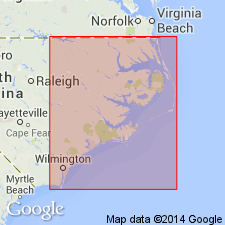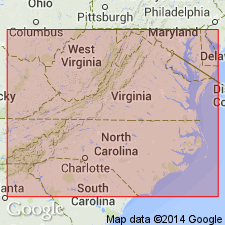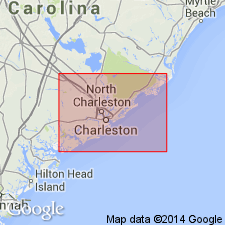
- Usage in publication:
-
- Pollocksville Member*
- Modifications:
-
- Named
- Biostratigraphic dating
- Dominant lithology:
-
- Limestone
- AAPG geologic province:
-
- Atlantic Coast basin
Summary:
Named as member of Belgrade Formation (new). Named for excellent exposures in vicinity of Pollocksville, Jones Co., eastern NC. Crops out from Belgrade to Pollocksville along Trent River. Consists of leached, tan to orange, unconsolidated, very arenaceous CRASSOSTREA bed (described by Lawrence, 1975). Maximum thickness is stated as 3 m, although thickness at type locality is stated as 4 m. Unconformably overlies uneven and eroded surface of River Bend Formation (new). Nearshore equivalent of Haywood Landing Member of the Belgrade. Age is early Miocene. Fossil assemblage in Haywood Landing Member indicates that it and Pollocksville Member are age equivalents of early Miocene Tampa Limestone in FL. Giant oysters of type found in Pollocksville are also common in lower Miocene part of Catahoula Sandstone of MS and AL. CRASSOSTREA also found just below weathered and burrowed sand of Hawthorn Formation at Shell Bluff, GA. Section at Shell Bluff shows same sequence as in Coastal Plain of NC (in ascending order: Claibornian sand, middle to upper Oligocene siliceous limestone, silty CRASSOSTREA bed, middle Miocene Hawthorn). Although CRASSOSTREA is found in underlying Chickasawhayan sediments of River bend Formation, authors believe oysters of Pollocksville Formation and of Hawthorn Formation at Shell Bluff represent early Miocene appearance of CRASSOSTREA GIGANTISSIMA (Finch). Report includes geologic sketch map, correlation chart, columnar section, and detailed descriptions of type and reference localities.
Source: GNU records (USGS DDS-6; Reston GNULEX).

- Usage in publication:
-
- Pollocksville Member
- Modifications:
-
- Age modified
- AAPG geologic province:
-
- Atlantic Coast basin
Summary:
On the basis of its correlation with the Old Church Formation, Belgrade Formation and its Haywood Landing and Pollocksville Members are Oligocene and early Miocene.
Source: GNU records (USGS DDS-6; Reston GNULEX).

- Usage in publication:
-
- Pollocksville beds
- Modifications:
-
- Revised
- AAPG geologic province:
-
- Atlantic Coast basin
Summary:
Oligocene and lower Miocene stratigraphic nomenclature in NC was revised almost simultaneously by Baum and others (1978) and Ward and others (1978). According to authors, recent studies indicate that neither interpretation is accurate and further revision is necessary. The interpretation presented here is based on a combination of the earlier revisions. At their type localities, the Haywood Landing Member of Ward and others, and the Silverdale Formation (used here) of Baum and others contain calcareous nannofossils of Zones NP24-25 (late Oligocene), while the type section of the Belgrade Formation of Ward and others and the type section of their Pollocksville Member are early Miocene in age. The late Oligocene Belgrade (inshore) and Silverdale (offshore) Formations of Baum and others are used in this report. The overlying early Miocene Pollocksville (CRASSOSTREA beds of Baum and others) is reduced in status to informal Pollocksville beds. The Haywood Landing Member of Ward and others is not used.
Source: GNU records (USGS DDS-6; Reston GNULEX).
For more information, please contact Nancy Stamm, Geologic Names Committee Secretary.
Asterisk (*) indicates published by U.S. Geological Survey authors.
"No current usage" (†) implies that a name has been abandoned or has fallen into disuse. Former usage and, if known, replacement name given in parentheses ( ).
Slash (/) indicates name conflicts with nomenclatural guidelines (CSN, 1933; ACSN, 1961, 1970; NACSN, 1983, 2005, 2021). May be explained within brackets ([ ]).

